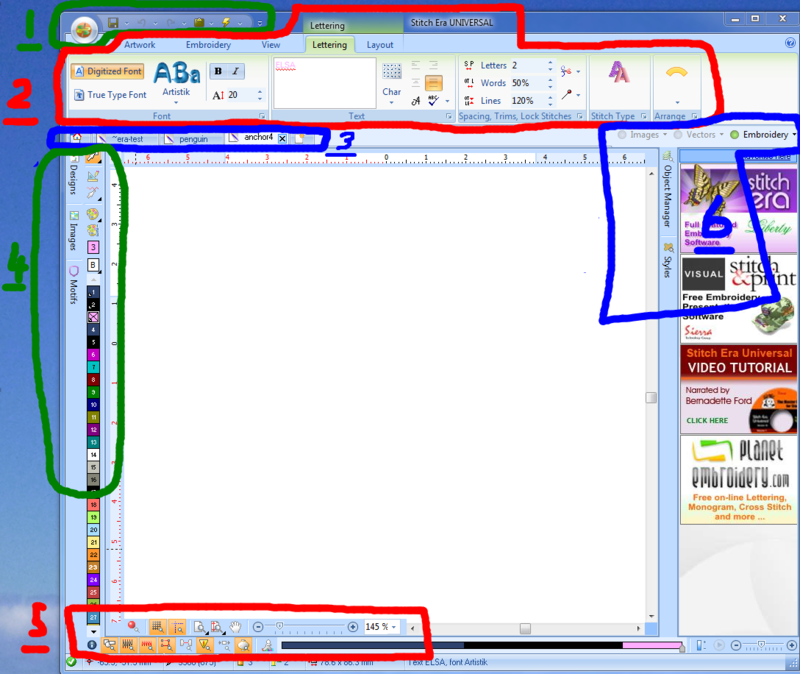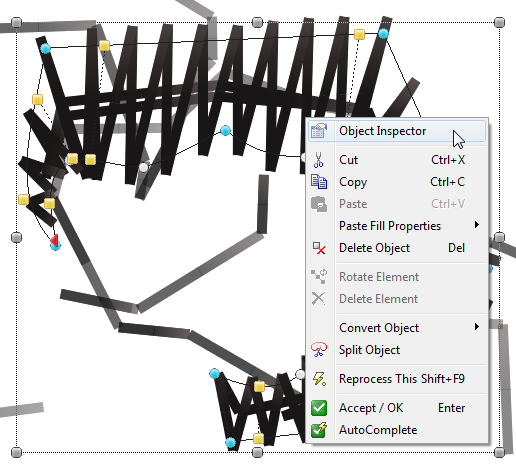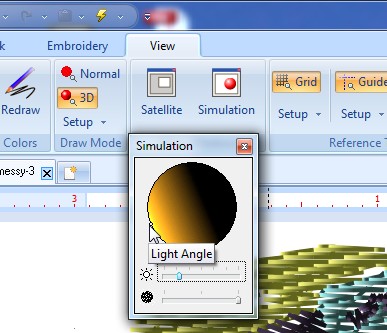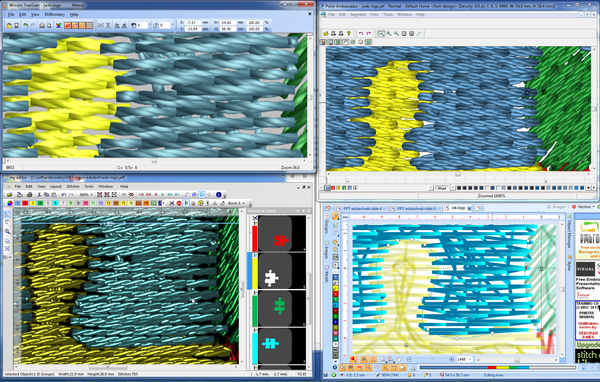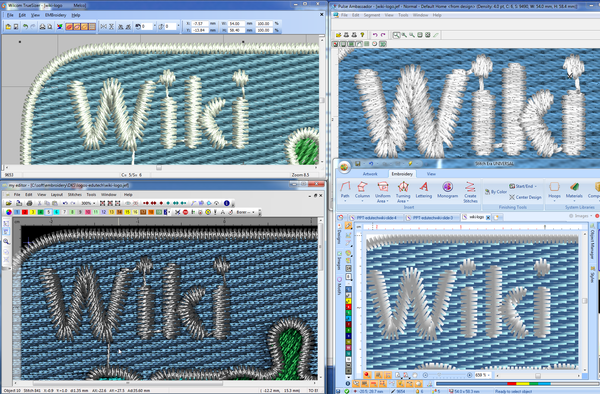Stitch Era - interface features for working with a design: Difference between revisions
m (using an external editor) |
|||
| Line 167: | Line 167: | ||
=== Processing of stitches === | === Processing of stitches === | ||
When you digitize a vector graphic you will create stitch sections. Alternatively you may directly | When you digitize a vector graphic you will create stitch sections. Alternatively you may directly draw stitch sections through the '''embroidery panel'''. However, we usually prefer creating a vector (art) object first. | ||
Stitch sections are '''not yet''' stitches. They | Stitch sections are '''not yet''' stitches. They just define the shape of an area or a path were stitches should go and also define lots of parameters, e.g. stitch density, type of fill, etc. | ||
In order to generate stitches, you either must press the '''generate stitches''' button on top ('''f9''') or you may turn on '''automatic generate''' in the '''generate stitches''' pull-down menu (lightning button on top in the quick access bar). | In order to generate stitches, you either must press the '''generate stitches''' button on top ('''f9''') or you may turn on '''automatic generate''' in the '''generate stitches''' pull-down menu (lightning button on top in the quick access bar). | ||
Revision as of 19:37, 4 October 2011
<pageby nominor="false" comments="false"/>
Introduction
Stitch Era has a fairly complex interface. The purpose of this tutorial in the Stitch Era embroidery software series is to introduce some features and tricks that you will need for many different tasks. We will not explain how to draw and manipulate vectors, stitch sections, etc. but introduce some tools that will help you understanding what you have got on your screen and introduce the idea that you can change the (many) properties of each object in quite simple ways.
This tutorial is by no means complete. I will add stuff now and then .... Daniel K. Schneider 17:11, 18 June 2011 (CEST)
Interface layout
Let's just recall the general layout of the interface. The annotated screen capture below shows its most important areas. In this tutorial we will focus on stuff that is "below" and "to the right" in the Stitch Era Window.
- File Menu button and quick access toolbar
- Open / write design and embroidery files
- (Re) process stitches (lightning menu)
- Main tools / Ribbon bar
- These can change contextually.
- Artwork
- Allows to import bitmaps and vector graphics
- Draw vector shapes that do not include stitching information yet. This is maybe the preferred way to start drawings as opposed to directly inserting stitch parts available through the Embroidery tab or Designs->Create sections.
- Embroidery
- Define materials and hoop
- Retrieve patterns
- Allows to insert stitch parts
- View
- Allows to define various view parameters (including a refresh button and a satellite view)
- Includes snap and measure tools
- Body
- Change parameters of a fill (shapes)
- Border
- Change parameters of a stroke (lines)
- Layout (Rescale, rotation, etc. but also repetitions)
- Tabs on top of ribbon bar show types of selected object and help you understanding what you can do with it.
- Area (shows what you can change for a selected part, i.e Body+Border+Layout)
- Path (shows what you can change for a stroke, i.e. border + layout)
- Lettering (shows that you can change lettering and layout)
- Block (shows that you selected more than one object)
- Artwork (shows what you can do with selected vector graphics)
- Convert (shows that you could convert a vector image to stitches)
- Package ?
- Document bar
- Allows to open/close documents and create new ones.
- Clicking on the home icon will bring you to the start page.
- Show/hide vectors/stitch sections (to the very right, near the object manager). These buttons are important.
- Create and edit tools / color management / color palette
- Some of the functionalities are also available through the main menu
- Designs
- Select Object (press mouse button for a while for options): Press this to return to select mode !
- Create Sections: Define how to create new different kinds of parts, i.e. fills vs. strokes, kind of stitches.
- Edit Stitches
- Images (changes contextually, e.g.:
- When stitchable object is selected: Change Color palette and optimize Needles
- When a vector object is selected: Change color, etc.
- Motifs
- Provide information about "needles" that will be used. In single needle machine, think of this as threads that you will have to change.
- Double-click allows to change parameters, e.g. the color, thread make/model and number.
- Display and reference controls (at the bottom)
- Object manager, Inspector and Styles (to the right)
- The object manager gives you fine grained control over images, vector objects and stitch objects. Open it all the time, if your screen is large enough !
- Recall: the three little toggle buttons (images, vector objects and embroidery objects) on the document bar allow to show/hide these three types of objects.
We call the big rectangle in the middle, where you can see your design, the workspace
The Object manager and the object inspector
The object manger and the inspector are handy and crucial tools for working with stitch sections. Most parametrizations can be achieved through these two tools (as opposed to using the ribbon menus or the context menu).
Please locate the Object manger (vertical tab to the right). We shall use it very often. When you open it, it will also display the object inspector.
The Object manager lists pictures, vectors and embroidery objects (stitch sections)that you are using in a design.
Items in the object manager are sorted according to stack and stitch order. Objects being displayed / stitched last are at the end. You can change order by dragging one or more items up or down. Press the CTRL or the SHIFT key to select several. You also could change order by clicking on the More tab in the inspector and then change through the "123" button. Finally, each object is displayed with some summary information.
- Vector objects show ordering number, type, border, etc. Filled, border-only or fill+bordered items show differently.
- Stitch objects show ordering number, type, underlay type and number of stitches
Grouped items show as so-called packs.
When you select an embroidery object in the manager or when you click on an object in the workspace (doesn't matter) you will see its properties in the Object Inspector.
In the screen capture above, you can see the "body" (fill) properties of a stitch area that is a so-called area pattern. E.g. you can see that we use a pattern called PTM-0044 and that stitch density is 4 lines/mm. All these parameters can be changed. In the borderline tab you then could add a border (e.g. a zigzag stitch) and in the More tab you can define exit/entry points and trims. Note: You also can change parameters through the menu bar on top, but I prefer doing it through the inspectors. Both methods are just fine.
When you use auto-digitizing procedures as we do, you rather would define parameters for fill and pattern type earlier, i.e. before you create the stitch section from drawing vectors. However, I found that often some adjustments to stitch sections are necessary.
Show and hide objects
You should be aware all the time whether the tiny little vectors and embroidery buttons (at the upper right of the workspace) are on (green) or off ("red") or inactive ("grey"). In other words, you can hide stuff and not see it anymore...
Killing objects
You can select one or more objects in the object manager and then kill them by pressing CTRL-X. Like in most programs, holding down the SHIFT key allows to select several objects in a row and pressing CTRL allows to pick out several single objects.
Important notice about embroidery - vector editing round tripping:
If you decide to rather work at the vector objects level, then you probably want to go back to vector level if you notice that some drawings don't render as they should because the drawings need adjustments.
You now have two options:
- Kill all embroidery objects. To to so, click on Sections in the Object Manager (this will select them all), then hit CTRL-X. We suggest not to use CTRL-A in the workspace and then kill since you also may kill all the vector objects that way ....
- Kill selected embroidery objects only. In that case you will have to re-digitize just the vector objects that were used to create these. The procedure is the same. Select the (maybe redesigned) vector objects and click on To Embroidery -> Art to Stitch (or some other digitizing method).
In any case:
- Avoid killing vector objects by mistake
- Avoid generating two or more stitch areas that represent the same vector object (unless you want to, e.g. if you plan to generate a manual border and a fill separately you would use the same vector shape and digitize once with a border and once with a fill). In short, before re-digitizing: kill the stitch section(s) that you want to replace. Else you will stitch two or more of the same.
Objects in the workspace can be manipulated through a context menu (in addition to other tools).
Below we just show a few examples that demonstrate the fact that many operations on a selected object or a selected part of an object (like a node) can be achieved through this quick access method. The same operations are usually available through the main menu on top and/or the object inspector.
Dealing with embroidery objects, i.e. a Zigzag area:
The following screen shot shows that instead of using the right-click menu in order to change the Fill-mode, you also could do this through the main menu bar. In addition one could use the inspector shown to the right.
The following picture shows that you will get a different menu when you click on one of the little dots that will show after selecting an object. This is somewhat tricky (zoom in lot). The selected dot just on top left of the menu is a so-called corner node that defines a turn in the area shape definition. The yellow points define lines that define stitch directions, etc. Stuff that we won't explain here. We just wanted to show that you should be aware of what you selected on the screen.
The picture below demonstrates that vector objects are simpler than embroidery objects. However, drawing operations are simpler and that's the reason why I prefer creating designs with vector graphics first.
Getting out of a tool
If you think that you are stuck with editing something and want to abort, try two things:
- ESC - escape from editing / drawing something
- F11 - escape from a tool, i.e. put the work area/mouse in selection mode
- If you were zooming with F6, hit F6 again
Zooming
When working with vectors and embroidery objects you sometimes have to zoom in a lot.
- To zoom into the right spot,
- Click on the zoom area tool bottom or hit F6,
- then move the cursor over the center of area you plan to work with.
- then rotate the mouse wheel.
- Another zooming-in option is to use the pull-out menu of the same zoom area button and select the zoom level. Professional seem to work at 600%...
- To see the whole picture again: Click on the button next to it (Maximize Total) or hit CTRL-F6
- Finally, if zoomed, you need to see other parts of your design, you can use the hand to "drag" the workspace around (nothing will be changed in the drawings just your view of it ...)
F6 / CTRL-F6 are the only two shortcuts I know by heart for now. I really use it all the time...
Hiding and locking objects
We mentioned this before, but often you have to turn on/off either view of vector objects or view of stitch objects. If both are on, you may get confused. As rule: Always turn of vector object view when you edit stitch sections !
- Use the little buttons on top right to turn on (green) or off (red)
Now these buttons are also pull-down menus that give you additional hide/unhide and lock/unlock facilities.
You may for example hide stitch sections. This is very convenient when you work with objects that print on top of each other. See the screen capture below.
Warning: Before you freak out if at some point you can't see vectors or embroidery stitch sections or parts ... have a look at these tools. They will tell what should show/not show and what is locked/unlocked !
Rendering of stitch sections
Processing of stitches
When you digitize a vector graphic you will create stitch sections. Alternatively you may directly draw stitch sections through the embroidery panel. However, we usually prefer creating a vector (art) object first.
Stitch sections are not yet stitches. They just define the shape of an area or a path were stitches should go and also define lots of parameters, e.g. stitch density, type of fill, etc.
In order to generate stitches, you either must press the generate stitches button on top (f9) or you may turn on automatic generate in the generate stitches pull-down menu (lightning button on top in the quick access bar).
We rather suggest not to use the automatic generation since it puts quite a lot of strain on the processor when you make lots of modifications to the stitch sections.
Looking at the stitches of your design
You can look at stitches in two fundamentally different ways.
- Normal view, i.e. some sort representation that shows stitches as dots and lines
- 3D view, a kind of simulation that shows how the printed object would look. This simulation is not very good, but nevertheless helpful.
To turn 3D view on/off, use the little red ball in the lower left or hit 'F7
The 3D view can be parametrized:
- quality (slider)
- luminosity (slider)
- light source angle (turn the ball)
To to do, use the View tab in the main menu, and click on Setup in the Draw Mode panel as shown below.
If a static view is not enough, you then can examine and simulate the stitching process in three ways as shown in the screen capture below.
1) If you tick Navigation View, navigation controls will appear to the right of the play head and and that allow you to navigate forward and backward in your design and jump to different points of interest, e.g.
- section to section
- stitches by 10's or 100'.
- color to color
2) To the very right, there is a simulation player (including a control for speed and thickness of stitches). Hit the little forward arrow in order to simulate what your embroidery machine will do.
3) you also can move the play head forth and back (left/right). The play head is the little white cursor that looks like a house.
Depending on whether 3D view is on or off you will get a different view.
This tool is crucial for spotting potential trouble in your design, e.g. parts that are stiched over others when they should not. Of course, you do think about these things, but there is always 1 or 2 things that are missed.
Finally, the simulator tools also to enter Stitch Editing mode through the little pull-down button (something we don't do yet). I believe that you will land on the stitch where you halted the simulation.
To exit from the stitch editor is not obvious, hit the the select object button in the design panel upper left or hit F11
Finishing tools
When you work on a larger complex design and auto-digitize from vector art, you may wind up with lots of stitch sections that are not ordered by needles. This will then cause a problem for folks who hate changing threads.
You may use the By Color tool in the Embroidery tab as shown aside and as explained in more detail in the Stitch Era - vector and thread color tutorial.
However, if you designed a careful stack order beforehand - in particular if you digitize from vector graphics - you easily can mess up everything. I.e. you will have to move sections again in the object manager.
Use it, but with care ....
Using other software to look at your design
I find the Stitch Era 3D rendering of designs good enough to see what roughly will happen. However, other (free) programs provide much nicer results. As you can see in various tutorials, I sometimes use these when I don't feel embroidering a design and/or taking pictures.
- WILCOM TrueSizer. Reads most formats.
- Bernina Artlink, reads most formats, but cannot read *.jef
- Pulse ambassador Reads most formats and includes an animation tool for the stitching process (little icon on top).
- MyEditor produces the most pretty 3D view, since it includes a shader, i.e. simulates the effect of light source. You may set the position of the source and its intensity (menu View->Set Light source). Finally it has a color manager, a sequence viewer and a practical radar window (Menu View->Rollups)
The caveat of using such software is that none will read Sierra *.dsg files. I.e. you will have to produce an embroidery file first. In the picture below you can see the same *.jef file. Colors may come out wrong. Also, the relation between thread colors in Stitch Era and the way *.jef files encodes this information is something that I don't fully understand yet. I.e. would it have made a change if would have used a Madeira palette instead of the system one ?
My two favorite programs are Wilcom (simple to use and accurate) and MyEditor (most pretty and radar view panel)
